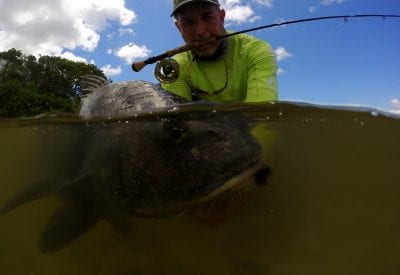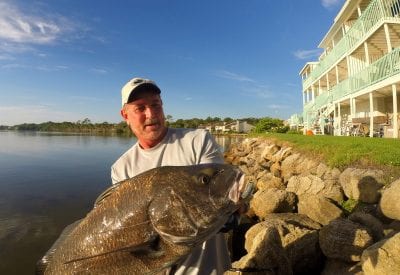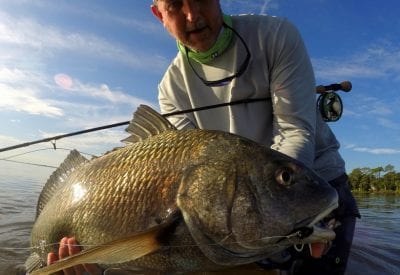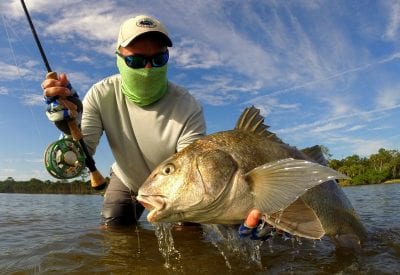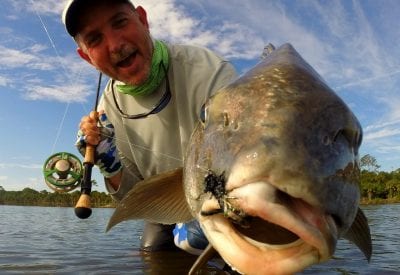Paul MacInnis
Occasionally inspiration for an article comes from unexpected places. So is the case for this article. Roger Hampton and his construction crew were at my townhouse community for post Irma hurricane repairs. Like any wise angler, Hampton and his crew took advantage of our waterfront location to soak baits while they went about their work. Every afternoon I’d chat with Hampton, not about the restoration work, but about what they caught that day. There was of course catfish, an occasional seatrout or whiting, but the star was black drum. On their best day they caught 15 that ranged from 20 to 27 inches long.
That got me thinking about black drum. I’ll admit, with seagrass die-offs and other Indian River Lagoon woes, I’m not catching as many seatrout and redfish as I used to. But I am catching more black drum than ever. Maybe their population is expanding due to reduced competition from trout and reds.
One look at a drum (Pogonias cromis) with its chin barbels and underslung mouth and you can tell this fish feeds on the bottom. Although they are occasionally caught on cut bait, black drum feed primarily on mollusks and crabs. Shrimp, clams, crabs and sand fleas are popular drum baits in our local waters. My favorite is crab because they don’t tend to get eaten by catfish and aren’t as readily picked apart by bait stealers as the other baits. One blue crab can yield four baits; each claw and then cut the body in half for two more baits. I use a 4/0 to 6/0 Daiichi circle hook and run it through the elbow joint on the claws. For the body halves, I’ll insert the hook near the “point” at the corner of the shell. If you wiggle and pivot the hook back and forth you can “drill” the hook point through the shell.
Just about every major bridge on the Indian River Lagoon has a population of black drum, and some of them are huge. There are a handful of specialists who target these fish, usually by soaking blue crabs on the bottom near pilings. This is a heavy tackle, locked down drag game. Fights are short but intense; either you winch the fish to the boat or the fish gets back into the pilings and cuts you off. This type of fishing is usually better at night, but there are a few guides like Captain Tom Van Horn who successfully target bridge drum during daylight by cruising along the bridge with their side imaging sonar to spot fish for their clients to cast to.
My favorite place to target drum is on the flats where they can be sight fished just like redfish. A live or dead shrimp or chunk of crab cast into their path is likely to get eaten, but the real fun is trying to catch black drum on lures. Drum aren’t the easiest fish to fool on artificials, but I can offer a few tips that should help your success. First, you lure needs to be on the bottom. It is extremely rare to have a drum rise up in the water column so you should use flies, jigs, plastic shrimp or crab imitations with enough weight to get to the bottom quick. Second, use dark colors. Black is my favorite but dark brown or root beer also work. Drum occasionally strike lighter colors, but most of the time black or root beer will out fish lighter colors ten to one. My third tip is to put your lure right on the drum’s nose. A black drum won’t chase down your lure so you have to present it right in front of the fish. I like to imagine a circle about the size of a dinner plate in front of the drum’s nose and then try to drop my offering in that circle. Once I get a lure in front of a black drum I like to twitch it slowly, keeping it on the bottom and in the drum’s line of sight. Hits can be subtle and sometimes are hard to see and feel. If you think you’ve been bit, slowly come tight and be ready to set the hook if you feel weight.
Black drum on the flats tend to run from a few pounds on up to about 30 pounds. The same tackle you use for redfish will work for black drum. I personally use a seven foot spinning rod with a 2000-3000 size reel loaded with ten pound test braid. I add about two feet of 20 pound mono or fluorocarbon leader, not so much because drum are line shy, but to give me something to grab when trying to land a fish.
For fly fishing I prefer a seven weight fly rod although most folks opt for a nine weight for throwing heavy flies and for a little extra backbone when pulling on fish that may top 20 pound. Although you want to present your fly on the bottom, floating line works fine because fly fishing for drum is a shallow water game. Weighted black flies that get to the bottom quickly are best with my favorite patterns being the Redfish Worm, Merkin and Clouser Minnow (http://www.spottedtail.com/blog/mosquito-lagoon-florida-fly-fishing-tip-little-black-flies/).
If you want to keep a black drum for the table, the limit is five fish per day between 14 and 24 inches long, with one allowed over 24 inches.
By Paul MacInnis

